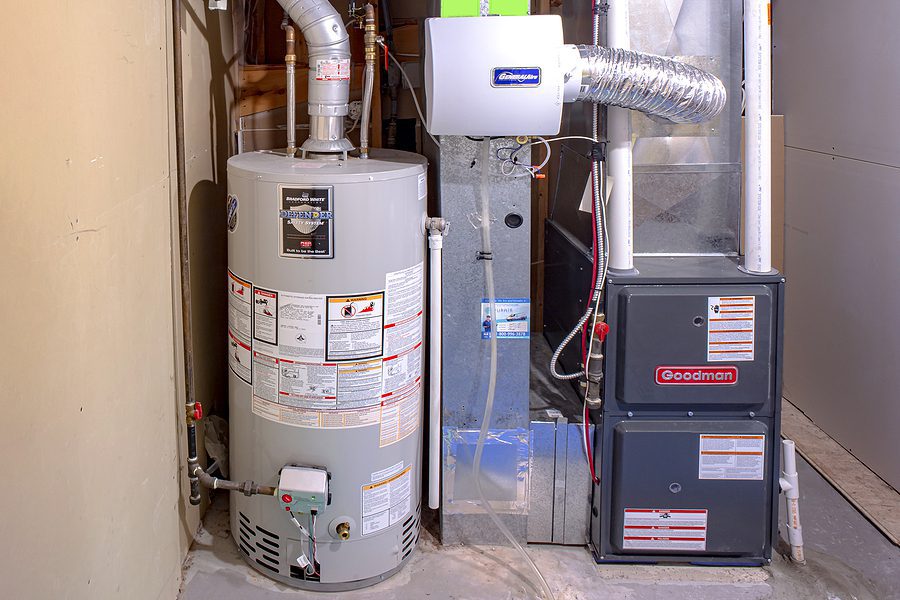
Is there anything worse than your furnace conking out in the dead of winter? You wake up in cold. Crank up the thermostat – then nothing.
We know this is stressful, but stay calm. Plenty of homeowners deal with furnace problems every year.
There are solutions, anyway.
In this guide, we’ll cover the most common furnace issues. Why they happen. And what you can do to get that sweet, sweet heat flowing again. Let’s dive in!
Common Problems You May Find
It Won’t Turn On At All
First thing’s first: double check your thermostat. Is it on and working properly? If the display is blank, replace the batteries. Easy peasy.
If the thermostat looks good, make sure your furnace is plugged in all the way. The access panel must be closed too. Silly mistakes like these can prevent proper operation.
Next, check if the furnace circuit breaker tripped. Head to your electrical panel. If the breaker is in the “off” position, flip it back on. If it’s somewhere in-between, switch it fully off, then on again.
Did the breaker stay on? Could have just been a minor fluke. But if it trips repeatedly, you likely have an electrical issue. Time to call an electrician for professional diagnosis and repairs.
The Blower Fan Is Hot
Hot air is blasting…and blasting…and blasting. Your blower fan is running nonstop! That’s just wasting energy.
If your thermostat is set to “auto” mode, the furnace should cycle off once it reaches the set temperature. A continuously running blower means there’s an issue.
The likely culprit? A faulty limit control switch. This crucial safety component monitors air temps and shuts your system down if it overheats. Replacing or repairing it requires an HVAC pro’s expertise – expect to pay $150 to $400.
Weird Noises From the Furnace
Some operational noises are normal. Soft clicking as it cycles on, or the “whoosh” of air flowing through ductwork. But loud, abnormal sounds are bad news. They indicate a potential problem that needs addressing ASAP.
Here are some common furnace noises and their causes:
Grinding or Scraping Sound This unpleasant noise means the ball bearings are worn out. Stop using the furnace immediately before further damage occurs.
Squealing or Shrieking Does it sound like nails on a chalkboard? Your blower belt has likely slipped loose or worn down. You can try adjusting or replacing it yourself if you’re handy. Otherwise, leave it to the pros.
Knocking or Rattling Something has come loose inside and is knocking around. Time for a tune-up to tighten or adjust any loose components.
Loud Rumbling Fuel may be getting trapped in the combustion chamber after the burners shut off. That can cause an unsettling rumbling or booming noise.
For any persistent or extreme furnace sounds, your safest bet is contacting an HVAC technician. They can properly diagnose and repair the issue.
The Pilot Light Is Struggling
With older furnace models, you may run into pilot light problems. The flame could be too small and weak. Or it may keep going out entirely.
There are a few possible explanations:
- The flame sensor (or thermocouple) needs cleaning or replacing. This safety device detects if the pilot is lit and signals the furnace to shut off if not.
- The gas burner is clogged with debris, preventing proper gas flow.
- You may just need to relight and adjust the pilot yourself according to the owner’s manual.
Working with natural gas is extremely dangerous if you don’t know what you’re doing. For any pilot light issues beyond a simple relight, your best move is calling a professional furnace repair service.
The Air Filter Is Beyond Dirty
Air filters trap dust, dander, and other airborne particles. This keeps them from circulating through your home and furnace. But when was the last time you changed yours?
Clogged, dirty filters restrict airflow. That forces your furnace to work harder, driving up energy costs. Even worse – insufficient airflow can cause overheating and automatic shutdown. No heat at all!
Check and replace those furnace filters regularly – at least every 3 months. It’s an easy DIY maintenance task that extends your furnace’s lifespan.
Carbon Monoxide Leak (Very Dangerous!)
This is the big one. A cracked heat exchanger can leak carbon monoxide – an odorless, deadly gas. If you experience any of the following, shut off your furnace and exit your home immediately:
- Soot buildup inside the furnace
- Chemical or metallic odor
- Water leaking near the unit
- Headaches, nausea, or flu-like symptoms
These indicate your heat exchanger is compromised and leaking carbon monoxide. This can cause poisoning within minutes! Don’t risk it – evacuate and get an HVAC technician out ASAP.
Strange Furnace Odors
Speaking of strange smells, there are a few furnace odors that should raise red flags. Note the specific scent and then take the proper precautions:
Burning or Metallic Smell This likely stems from an electrical issue – maybe an overheated motor or wiring. While it’s probably not an emergency, don’t ignore it. That burning smell could intensify into a fire hazard. Get it checked out soon.
Rotten Egg or Sulfur Stench This pungent odor = gas leak! Shut off your furnace, open up windows, and get out of the house ASAP. Once outdoors, contact your gas company immediately to report the leak.
Musty or Moldy Scent If you’re smelling must or mold, you probably have moisture infiltrating your furnace or ductwork. Mold and mildew can circulate through your air supply – unhealthy for breathing! Call a tech to find and fix the moisture issue.
Dusty “Furnace Restarting” Smell When you first fire up the furnace each season, you may notice a dusty, burning smell. That’s just dust burning off from months of inactivity. As long as it dissipates within a few hours, no need to worry.
In general, any persistent or intense furnace odors aren’t normal. For your health and safety, don’t just ignore them! Get to the bottom of it with a professional inspection.
The Circuit Breaker Keeps Tripping
Modern furnaces operate on both gas/oil and electricity. So if the circuit breaker supplying power to your unit keeps tripping, there’s likely an electrical issue at play.
Some potential causes:
- A malfunctioning blower motor or other component drawing too much current
- Clogged filters restricting airflow and overworking the system
- Faulty wiring or connections within the furnace’s electrical setup
- Circuit isn’t properly sized to handle the furnace’s electrical load
Whatever the reason, a tripped circuit breaker signals a larger electrical problem within your heating system. Don’t just keep resetting it – that’s a temporary band-aid. Get an electrician out to assess and repair the root issue.
How to Troubleshoot Furnace Issues Yourself
While you’ll likely need a pro for complex furnace repairs, some basic troubleshooting is within most homeowners’ abilities. Just remember – safety first! If you ever smell gas or suspect a carbon monoxide leak, stop what you’re doing and call for emergency service.
For other issues though, here’s a basic checklist to start your troubleshooting:
- Check thermostat settings and batteries
- Ensure the furnace is receiving power (plugged in, circuit breaker on, emergency switch engaged)
- Replace or clean dirty air filters
- Listen for abnormal sounds like squealing, banging, rattling
- For gas furnaces, check that the pilot light is lit and gas supply valve is open
- Inspect the furnace for any error codes on the LED display
- Look for any blocked vent or flue pipes
Go through these basics first. If you still can’t get your furnace running, it’s probably time to bite the bullet and schedule an HVAC technician to swing by for a professional diagnosis and repair.
Why It Needs Routine Maintenance from Professional
Dealing with furnace issues is never fun. But you know what’s even less fun? Scrambling to find a 24/7 repair service when your furnace conks out at 2 a.m. on a subzero winter night!
The best way to avoid emergency furnace situations is preventive maintenance. Have an HVAC pro inspect and service your furnace every fall before heating season kicks in.
During a tune-up service, they’ll thoroughly clean and inspect every component. They’ll check for any worn parts and make adjustments to ensure peak efficiency. Spending a little on maintenance now can prevent headache-inducing breakdowns later.
FAQs
I’ve noticed black soot around my furnace. What’s the deal?
Soot buildup is often a sign of incomplete combustion, which could be caused by a cracked heat exchanger or other serious issues. This is a major red flag that you need professional help ASAP, as it could be leaking deadly carbon monoxide into your home.
My furnace keeps cycling on and off rapidly. Is this normal?
No, it’s not. Rapid cycling, also known as “short-cycling,” puts extra strain on your furnace and can lead to premature breakdowns. The culprit could be anything from a faulty thermostat to an oversized furnace for your home. Get a pro to diagnose and fix the underlying issue.
I heard a loud boom from my furnace. Now what?
That alarming boom was likely caused by a delayed ignition, where unburned gas accumulated before igniting all at once. Shut the furnace off immediately and call for service, as this can be a fire hazard and may have damaged internal components.
Why does my furnace keep resetting itself?
If your furnace randomly resets or shuts off on its own, it could be due to a safety mechanism kicking in to prevent overheating or other hazards. Potential causes include a dirty air filter, blower failure, or thermostat issues. Don’t ignore this – have it checked out.
My furnace is leaking water. Is this an emergency?
It could be, yes. A leaking furnace is never a good sign, as it could mean a cracked heat exchanger (which can spill deadly carbon monoxide) or other serious problems. Shut the furnace off and call for professional help immediately to diagnose and repair the issue safely.
The furnace is on, but no air is blowing out of the vents. What’s going on?
Sounds like your blower motor may have kicked the bucket. But it could also be something like a slipped blower belt or blocked ductwork. Either way, you’ll likely need a technician to inspect and repair whatever is preventing that all-important airflow.

